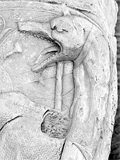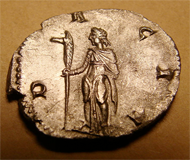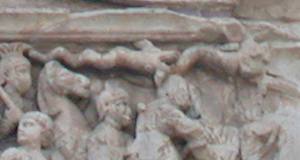
This page created 20 April 2014, and last modified: 7 December 2015 (Maier reference numbers added)

The Equites Marcomanni is listed (102/5.24 in Ingo Maier's numbering scheme) as the 12th of the 32 vexillationes comitatenses in the Magister Equitum's cavalry roster; it is assigned (102/5.234) to the Comes Africae. Its shield pattern (101#2) as shown in various manuscripts, under the plain label (101.b) Marcomanni, is as below:

The shield shows a white ground with an indigo/purple boss (faded to pink in M, W), along with two main charges, both in yellow: a crescent at the 10 o'clock position, point upwards (2 o'clock in B, which, being printed, reverses all the shield facings), and what appears to be a draco - a military standard that was introduced to the Roman forces during the 2nd century AD as a result of the Dacian wars, and which became more popular with time, to judge from e.g. Vegetius, in which a cohort is given its own standard, kept by a draconarius. Despite the name "draco" (serpent, dragon), illustrations of dracones often seem to feature a head that looks more wolf-like than serpent-like.

|

|

|
|
|
|
|
|
|
|
|
The name Marcomanni comes from the Germanic tribe of the same name, and which is believed to mean "the frontier ('march') people ('man')"; they were a sub-branch of the Suevi (Swabians). They fought some major conflicts against the Romans, especialy under Marcus Aurelius in the 2nd century, and in the early 5th century - the period during which the western portion of Notitia was being amended - they may have formed a portion of the Suevi that managed to penetrate across the Rhine in conjunction with many Alans and Vandals, and settle in northwest Spain, founding an independent kingdom that lasted over 170 years until absorbed by the Spanish Visigoths. Other Marcomanni listed in the Notitia are the:
Honoriani Marcomanni seniores (98/9.73), a unit of auxilia palatina unassigned to any field command,A unit of Equites Marcommani was stationed in Egypt over a hundred years before the time the Notitia was first compiled; the (west) African unit may vey well be one and the same. No unit of Equites Marcommani is stationed in Egypt according to the Notitia; its latest attestation there is in 286-7.
Honoriani Marcomanni iuniores (98/9.74), another similarly unassigned unit of auxilia palatina,
Marcomanni (102/5.89), a unit in the Magister Peditum's Italian command, and possibly equal to one of the above auxilia palatina units, and the
Gentes Marcomanni (145.12), a "unit" under the Dux Pannoniae primae et Norici ripensis.
1. Ingo Maier; "Appendix 4: Numeration of the new edition of the compilation 'notitia dignitatum' (Cnd)"; last accessed 26 October 2015. See also for here for numbering examples. Return
2. Publius Flavius Renatus Vegetius ("Vegetius"); "Epitoma rei militaris", 2.13; available here in Latin and here in English (last accessed 3 December 2015). Return
3. A.M.Kaiser; "Egyptian Units and the reliability of the Notitia dignitatum, pars Oriens"; Imperium and Officium Working Papers (2014); available here, at p 6 and note 25 (last accessed 6 December 2015). Return

Return to the Notitia alphabetical unit list page.
Return to my Notitia index page.